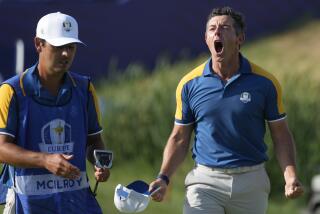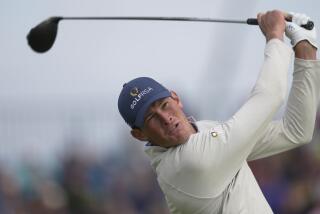RYDER CUP : Intensity Cuts Through Fog at the Belfry : Golf: Europe leads the U.S., 4-3, but the final foursome is even after 17 holes when finish is postponed because of darkness.
- Share via
SUTTON COLDFIELD, England — On a day that Tom Watson said was worthy of a novel, the best golfers from the United States and Europe arrived at the Belfry on Friday morning in a thick fog--how else should a novel set in England’s heartland begin?--and left more than 12 hours later in the night mist, having made virtually no progress in determining which side will hold the Ryder Cup after Sunday.
Due to circumstances beyond their control, they could not even provide a first-day leader. Europe was leading, 4-3, but the final foursome, the United States’ Paul Azinger and Fred Couples and Europe’s Nick Faldo and Colin Montgomerie, was even after 17 holes when the finish was postponed because of darkness.
Interrupted was a duel between two of the game’s finest at their finest. Azinger birdied three of his last four holes, only to be seen and raised by Faldo, who birdied four of his last five.
“This is what the Ryder Cup matches are all about today,” said Watson, the United States’ nonplaying captain. “This is the kind of day that makes these matches the greatest in golf.”
And this was merely the first chapter.
The start was delayed 2 1/2 hours because of the fog, which served only to heighten the players’ apprehension. The United States’ Corey Pavin, the first man to address a ball, was so nervous he could not manage to stick his tee in the ground.
“My hand was shaking a little bit,” he said.
The other 23 players no doubt sympathized with him. The competition is that intense.
Since 1983, in 140 individual, alternate-shot foursome and best-ball matches, Europe holds the edge by a mere five matches. The last time the teams met here, in 1989, they tied, 14-14. The United States won two years ago at Kiawah Island, S.C., by one point. Every match, every hole, every stroke could be the one that determines the winner.
“Honestly, this was one of the longest days of my life,” said Watson, a four-time U.S. team member who can only watch this time. “The pressure makes things go so slowly.”
For Watson and his European counterpart, Bernard Gallacher, emotional swings were dramatic. The United States started quickly in the alternate-shot format when Pavin and Lanny Wadkins beat Sam Torrance and Mark James, 4 and 3. But then a team that figured to be one of the Americans’ most formidable, Azinger and Payne Stewart, lost, 7 and 5, to Ian Woosnam and Bernhard Langer. It was the United States’ worst opening-day foursome loss since 1965.
Next up was Europe’s Spanish Armada, Seve Ballesteros and Jose Maria Olazabal, who had lost only once together in 12 matches since 1987. But they sensed they were in trouble when Tom Kite, who was playing with Davis Love III, boldly took a three-wood out of his bag and drove to within six feet of the pin on the par-four, 267-yard 10th hole.
“That was a brave decision,” Gallacher said. “I couldn’t believe it.”
Kite’s eagle gave his team a two-hole lead en route to a stunning 2 and 1 victory that could have demoralized the Europeans if Faldo and Montgomerie had not answered with an equally impressive 4 and 3 victory over Couples and Ray Floyd, sending the teams into the afternoon best-ball competition tied, 2-2.
And then it was Watson’s turn to be bold. He started two Ryder Cup rookies, Jim Gallagher Jr. and Lee Janzen, in the same pair. Gallacher countered with a rookie of his own, Peter Baker, but gave him an experienced partner in Woosnam. But it was Baker who played like the veteran, scoring four birdies in the one-hole victory.
Watson’s most dependable team of the day, Wadkins and Pavin, won again, 4 and 2, over Langer and Barry Lane to even the score, but Ballesteros and Olazabal unevened it in a grudge match against Kite and Love.
The Americans played well, six under par, but the inspired Ballesteros and Olazabal were spectacular with nine birdies and an eagle in a 4 and 3 victory. “We were 11 under after 15 holes, and there is no way that can be improved,” Ballesteros said.
With darkness approaching, only one foursome remained on the course.
They had been attacking each other furiously since the 10th hole, when Montgomerie drove his ball into a flower bed. He hit his next shot over a television tower and onto another fairway, where a steward figured Montgomerie was about finished and picked up the ball.
Meantime, when Azinger proceeded to hole out his putt, Montgomerie complained to the chief referee that the American had played out of turn. Disgusted because he and Montgomerie were being outplayed, Faldo told his teammate to get on with it, conceded the hole to Azinger and Couples and marched to the 11th tee.
Although there has been much talk since 1991’s “War on the Shore” in South Carolina about the Ryder Cup deteriorating into tag-team matches, that was as close to an incident as there was Friday. Even the fans, about 30,000 strong, were relatively well-behaved, as long as one was not offended by their occasionally cheering wayward shots and missed putts by the Americans.
But if the players were gentlemanly, that did not mean they were less determined.
Faldo hit a nine-iron to within 12 feet on No. 13 and birdied.
Azinger stuck the ball within five feet on 14 and birdied.
Faldo chipped in from 18 feet on 15 for a birdie, matched by Azinger’s putt from eight.
Azinger’s approach on 16 stopped one foot from the hole.
That was all Gallacher could take. He wanted to stop the match there because of darkness with the U.S. pair leading by one.
Faldo wouldn’t hear of it. Even though he could barely see, he hit a seven-iron from 157 yards to within five feet on 17 and sank a birdie putt to even the match.
“Nick is so mechanical, he plays in the dark even when it’s light,” Gallacher said.
Even Faldo agreed to postpone the 18th until this morning. But he said he can hardly wait.
“It’s great when you’re just playing pure golf out there. . . . There is nothing like it.”
More to Read
Go beyond the scoreboard
Get the latest on L.A.'s teams in the daily Sports Report newsletter.
You may occasionally receive promotional content from the Los Angeles Times.










